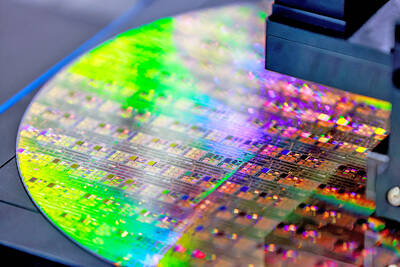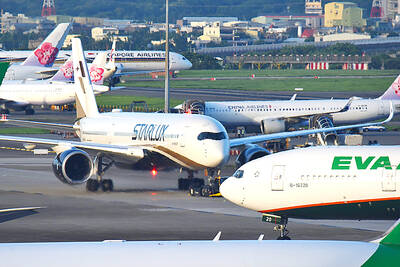The nation’s industrial production index rose by a better-than-expected 8.83 percent annually to 111.27 last month, driven mainly by the production of electronics components related to Apple Inc’s iPhone 7 sales, the Ministry of Economic Affairs said yesterday.
The growth not only exceeded the ministry’s estimate of 5 percent, but also marked the fifth straight month of annual increase, the ministry’s data showed.
However, industrial output in the first 11 months of this year rose a mild 0.95 percent from the same period last year, the data showed.
Manufacturing output, which accounted for more than 90 percent of industrial production, last month jumped 10.36 percent year-on-year, the largest increase since October 2014, the ministry’s data showed.
“Many market watchers had held a pessimistic view regarding the sales outlook of the iPhone 7, but statistics showed that export orders and the industrial output of iPhone-related sectors performed impressively over the past few months,” Department of Statistics Deputy Director-General Wang Shu-chuan (王淑娟) told a news conference.
For example, semiconductor production last month rose 37.64 percent annually on demand for communications chips used in smartphones and graphics chips for high-end gaming computers, Wang said.
However, production of computer electronics and optical goods contracted by 3.65 percent from a year ago, which Wang attributed to a Taiwanese smartphone brand’s falling output.
She declined to specify the company.
HTC Corp (宏達電) is the only Taiwanese manufacturer that produces smartphones domestically, at its Taoyuan plant, whereas other firms manufacture handsets offshore.
For this month, the ministry forecast that local manufacturers’ momentum would extend from last month, with an estimated increase in industrial production of 6 percent, as supply chains prepare for pre-Lunar New year inventory buildups, Wang said.
The Lunar New Year holiday is to run from Jan. 27 to Feb. 1.
Overall manufacturing output this year is expected to expand 1.7 percent annually, compared with last year’s annual drop of 1.49 percent.
In a separate news release, the ministry said that revenue of the wholesale sector rose 6 percent to NT$843 billion last month from the same period last year, due to positive market responses for smartphones, virtual-reality devices, TVs and gaming computers.
The retail sector benefited from Singles’ Day promotions and robust sales of imported vehicles, with revenue expanding 2.5 percent year-on-year to NT$357.8 billion, while revenue of the restaurant and beverage sector climbed 2.9 percent to NT$34.5 billion, Wang said.
Combined sales of the wholesale sector fell 2.3 percent annually in the January-to-November period, while the cumulative revenue of the retail sector rose 1.9 percent and the restaurant and beverage sector increased 3.4 percent.
Demand during the Christmas and Lunar New Year holidays is forecast to lift this month’s wholesale revenue by 2 percent annually, Wang said, adding that holiday shopping this month might boost retail and restaurant revenue by 4 percent and 3.4 percent respectively.

Taiwan’s rapidly aging population is fueling a sharp increase in homes occupied solely by elderly people, a trend that is reshaping the nation’s housing market and social fabric, real-estate brokers said yesterday. About 850,000 residences were occupied by elderly people in the first quarter, including 655,000 that housed only one resident, the Ministry of the Interior said. The figures have nearly doubled from a decade earlier, Great Home Realty Co (大家房屋) said, as people aged 65 and older now make up 20.8 percent of the population. “The so-called silver tsunami represents more than just a demographic shift — it could fundamentally redefine the

The US government on Wednesday sanctioned more than two dozen companies in China, Turkey and the United Arab Emirates, including offshoots of a US chip firm, accusing the businesses of providing illicit support to Iran’s military or proxies. The US Department of Commerce included two subsidiaries of US-based chip distributor Arrow Electronics Inc (艾睿電子) on its so-called entity list published on the federal register for facilitating purchases by Iran’s proxies of US tech. Arrow spokesman John Hourigan said that the subsidiaries have been operating in full compliance with US export control regulations and his company is discussing with the US Bureau of

Businesses across the global semiconductor supply chain are bracing themselves for disruptions from an escalating trade war, after China imposed curbs on rare earth mineral exports and the US responded with additional tariffs and restrictions on software sales to the Asian nation. China’s restrictions, the most targeted move yet to limit supplies of rare earth materials, represent the first major attempt by Beijing to exercise long-arm jurisdiction over foreign companies to target the semiconductor industry, threatening to stall the chips powering the artificial intelligence (AI) boom. They prompted US President Donald Trump on Friday to announce that he would impose an additional

China Airlines Ltd (CAL, 中華航空) said it expects peak season effects in the fourth quarter to continue to boost demand for passenger flights and cargo services, after reporting its second-highest-ever September sales on Monday. The carrier said it posted NT$15.88 billion (US$517 million) in consolidated sales last month, trailing only September last year’s NT$16.01 billion. Last month, CAL generated NT$8.77 billion from its passenger flights and NT$5.37 billion from cargo services, it said. In the first nine months of this year, the carrier posted NT$154.93 billion in cumulative sales, up 2.62 percent from a year earlier, marking the second-highest level for the January-September